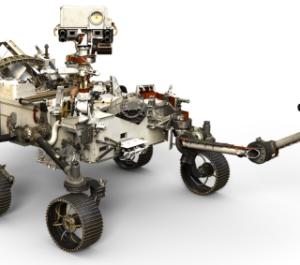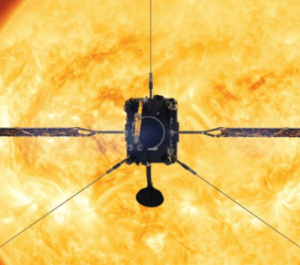NASA's first Mars helicopter has a name now and the credit goes to 17-year-old Indian-origin girl Vaneeza Rupani. Destined to become the first aircraft to attempt powered flight on another planet, NASA's Mars Helicopter officially named: Ingenuity, as suggested by Ms Rupani. While NASA announced in March that its next rover would be named Perseverance based on seventh-grader Alexander Mather's essay, the agency decided to also choose a name for the helicopter that will accompany the rover to Mars.
Indian-Origin Girl, 17, Names NASA’s First Mars Helicopter
NASA develops VITAL, a high-pressure ventilator to fight COVID-19
NASA (National Aeronautics and Space Administration) engineers developed a new, easy-to-build high-pressure ventilator named VITAL(Ventilator Intervention Technology Accessible Locally) specifically to treat COVID-19 patients. Key Points: VITAL is designed to treat patients with milder symptoms, thereby keeping the country’s limited supply of traditional ventilators available for patients with more severe COVID-19 symptoms. The device passed a critical test at the Icahn School of Medicine in New York, an epicentre of COVID-19 in the US (United States).
NASA, SpaceX Pick May 27 to Resume Astronaut Launches in US
NASA and SpaceX have picked May 27 for resuming astronaut launches from the U.S. after nine years of complete Russian dependence. NASA Administrator Jim Bridenstine announced the launch date . Astronauts haven’t launched into orbit from the U.S. since NASA’s last space shuttle flight in 2011. SpaceX aims to end the drought by sending two NASA astronauts to the International Space Station. Only three countries have launched people into orbit since 1961: Russia, the U.S. and China, in that order. SpaceX would be the first company.
NASA discovers habitable zone planet 300 light years away
NASA’s Kepler Space Telescope has discovered an Earth-sized planet in a habitable zone around a star that could support liquid water. The exoplanet, named as Kepler-1649c, was discovered by a team of of transatlantic scientists. The findings are based on the data provided by Kepler as well as Transiting Exoplanet Survey Satellite (TESS).
NASA announces SUNRISE Mission
NASA announced Sun Radio Interferometer Space Experiment (SUNRISE) mission.The mission is to study about how sun creates Giant Solar Particle Storms. Highlights Studying the solar storms, the mission aims to understand the working of the solar system. The study will also aid future astronauts travelling to Mars and protect them from solar storms. About the Mission The mission is to deploy six CubeSats in Geosynchronous-orbit. The mission has come true because of the success of DARPA High-Frequency Research and Mars Cube One (MARCO).
Nasa’s named Mars 2020 rover as Perseverance
NASA(National Aeronautics and Space Administration) announced the name of the 5th Mars (red planet) rover as Perseverance. Previously the rover was known by its codename as Mars 2020. The name was suggested by Alexander Mather, 7th standard student and was announced by Nasa’s director of science, Thomas Zurbuchen at an event in Lake Braddock Secondary School in Burke, Virginia. About Perseverance:The rover has improved wheel design which is used to collect the samples from the martian rocks and helps scientists to determine about the ancient microbial life that existed in red planet.
NASA’s Juno Update Jupiter Water Mystery
NASA's Juno mission has provided its first science results on the amount of water in Jupiter's atmosphere. Published recently in the journal Nature Astronomy, the Juno results estimate that at the equator, water makes up about 0.25% of the molecules in Jupiter's atmosphere - almost three times that of the Sun. These are also the first findings on the gas giant's abundance of water since the agency's 1995 Galileo mission suggested Jupiter might be extremely dry compared to the Sun (the comparison is based not on liquid water but on the presence of its components, oxygen and hydrogen, present in the Sun).
NASA’s ‘SuperCam’ to study mineralogy of Mars during Mars 2020 rover mission

NASA (National Aeronautics and Space Administration) is all set to send a new laser-toting robot named ‘SuperCam’ to Mars for studying mineralogy and chemistry from up to about 20 feet (7 meters) away, to help scientists in finding the signs of fossilized microbial life on the Red Planet i.e. Mars. SuperCam, a rock-vaporizing instrument is a part of seven instruments aboard the Mars 2020 rover. About Mars 2020 rover mission: It is part of NASA’s Mars Exploration Program which will launched between July 17 – Aug. 5, 2020 Cape Canaveral Air Force Station, Florida. It will land at Jezero Crater, Mars on Feb. 18, 2021. The mission duration is at least one Mars year (about 687 Earth days). The Mars 2020 rover is designed to better understand the geology of Mars and seek signs of ancient life.
NASA decommissioned its Spitzer Space Telescope after 16 years

The National Aeronautics and Space Administration (NASA) has decommissioned its Spitzer Space Telescope. The telescope which was used to study the universe by detecting cosmic infrared radiation for more than 16 years was first launched in 2003. Key points: Spitzer was planned to be decommissioned in 2018 in anticipation of the launch of the James Webb Space Telescope (JWST), but as JWST launch mission was postponed spitzer was given 5th and final extension till 2020. It detected the most distant galaxies ever detected with the light from some of the cosmic bodies travelling for billions of years to reach the telescope. It had also found a previously undetected ring around the planet Saturn.
New mission launched by NASA & ESA to take first pics of Sun’s poles

NASA(National Aeronautics & Space Administration) and ESA (European Space Agency) jointly will launch a new spacecraft- “The Solar Orbiter Spacecraft” to take first pictures of Sun’s north and south poles. The spacecraft will be launched from Cape Canaveral, United States on Feb 7,2020 on a United Launch Alliance (ULA) Atlas V Mission: The solar orbiter mission has 7 year lifetime and reach 24 degrees above the sun’s equator increasing to 33 degrees with additional 3 years extended mission operations. The spacecraft will pass within 26 million miles (42 million kilometers) of the sun which is the nearest approach.

